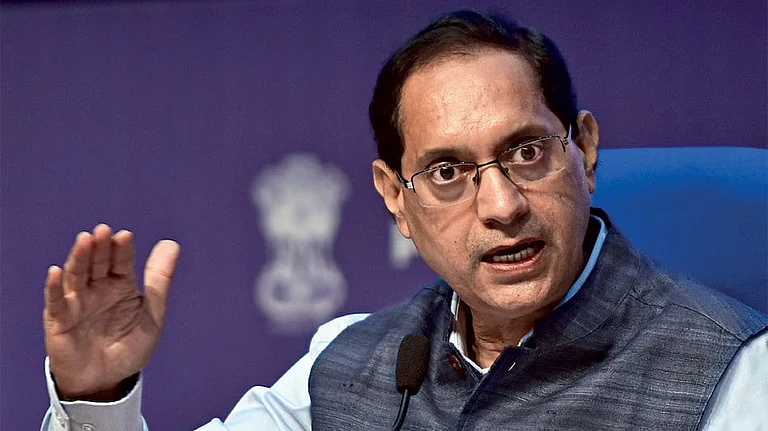At 9:15 AM sharp, when millions of Indians reach for their smartphones to check how the markets and stock prices are moving, an invisible empire springs to life. There is a complex network working in the background that transforms a single and simple tap on your phone into a direct transfer of wealth, irrespective of location and time zones.
SEBI Lays Out Roadmap to Strengthen Market Institutions' Governance
SEBI has come up with a consultation paper laying the foundation for tighter governance norms for MIIs. As India’s financial markets increase in size and depth, these MIIs will play an increasingly crucial role in maintaining the robust framework of investment landscape in the country
Behind every ‘buy’ and ‘sell’ command you give, there is an ecosystem that most investors never see, an empire without which trading would collapse faster than a penny stock. This ecosystem, made up of market infrastructure institutions (MIIs) make up the digital arteries through which trillions of rupees flow daily, connecting retail to institutions.
Moreover, as India’s capital markets evolve on the back of soaring investor participation, record trading volumes, and robust profits, the need for stronger checks and balances on these institutions is more urgent than ever. Recognising this, the Securities and Exchange Board of India (SEBI) on June 24 released a fresh consultation paper laying the foundation for tighter governance norms across the country’s MIIs.
This proposed overhaul focuses on the appointment of two full-time executive directors to the boards of MIIs, and defining the roles and responsibilities of key management personnel, apart from establishing the norms for directorships.
The SEBI proposal for mandating two executive directors for MIIs introduces a complex legal landscape, as it requires aligning with the SEBI Act, 1992, Depositories Act, 1996, and Companies Act, 2013, while amending MIIs’ Articles of Association to redefine leadership roles, Sonam Chandwani, managing partner at KS Legal & Associates said.
Along with improving day-to-day governance it might also reduce the risk of systemic oversight failures, Abhiraj Arora, partner at Saraf and Partners, said. If confirmed, these reforms will directly addresses long-standing issues of lack of independent oversight within MIIs and inadequate segregation of business and regulatory functions, he further added.
The proposal marks a critical step to address systemic negligence, as seen in NSE’s co-location case, by embedding accountability and specialised oversight, she further added. The NSE co-location fiasco was a landmark case related to capital markets in India that highlighted the negligence issue at the stock exchange back in 2015.
To that effect Arora said, "In complex institutions like MIIs, over-centralization can lead to blind spots. Appointing EDs for critical and regulatory functions is not just timely, it’s essential. It ensures that no single person has disproportionate control, and that both commercial operations and compliance arms function with independence and due diligence."
On June 26, the SEBI also slapped the BSE with a penalty of ₹25 lakh, citing failures in maintaining impartiality, transparency, and fairness in information dissemination. It was found that the BSE's system allowed both its internal listing compliance team and paid clients to access corporate announcements before they were made public.
Meanwhile, as India’s financial markets increase in size and depth, these MIIs will play an increasingly crucial role in maintaining the robust framework of investment landscape in the country, apart from safeguarding the interest of investors. As for investors, it is crucial to understand the scope and vastness of the MIIs.
Digital Vaults: NSDL vs CDSL
The two depositories—National Securities Depository (NSDL) and Central Depository Services (CDSL)—are the digital guardians of securities as they hold trillions of rupees worth of stocks, bonds, and mutual fund units in electronic form. These depositories were set up in 1996 and 1999, respectively.
While investors do not directly select which depository will hold their assets, their choice depends on the depository participant. However, major stock brokers often partner with both depositories.
The scale of both the depositories’ operations can be gauged from their dominance in various aspects of the markets. For instance, as of FY24, CDSL held a 76% market share in terms of account numbers, according to the depository’s annual report. CDSL had 11.56 crore active demat accounts as of March 2024.
However, it is the NSDL which leads in terms of value. It became India's first securities depository to reach ₹500 lakh crore in value of assets held in custody in September 2024, showcasing its continued dominance in high-value institutional holdings. The total value of demat under NSDL’s custody was over ₹495 lakh crore against 4 crore investor accounts as of May 2025, data from NSDL’s website showed.
On the other hand, the total value of demat securities under CDSL’s custody was just over ₹76 lakh crore, against a staggering 15.65 crore investor accounts as of May 2025.
This disparity creates intriguing revenue dynamics for both the company. Despite CDSL's overwhelming lead in account numbers and NSDL’s lead in demat value, the revenue gap between the two depositories remains surprisingly narrow. CDSL’s revenue for the financial year ended March 2025 was ₹848 crore, while that of NSDL was ₹619 crore. The gap, however, has widened in the last three years. In FY23, NSDL generated ₹409 crore in revenue, while CDSL amassed ₹451 crore in revenue. Revenues of NSDL and CDSL has grown 51% and 88%, respectively, in these two years.
Five Distinct Trading Arenas
The National Stock Exchange (NSE) and BSE dominate equity trading, with the total market capitalisation of NSE-listed companies at ₹473.84 lakh crore, as of September 27, 2024. Although the newly formed NSE has emerged as a larger platform, both serve crucial roles in the Indian equities markets.
The NSE’s notional turnover in equity derivatives segment fell 2% on year to over ₹78,359 lakh crores in FY25, while that of BSE’s jumped 243% on year to over ₹27,556 lakh crore. This disparity is also visible in their respective annual revenue. The NSE’s revenue for FY25 was ₹15,433 crore, six times the BSE’s revenue for the same period.
In the commodities space, the Multi Commodity Exchange (MCX) and National Commodity & Derivatives Exchange (NCDEX) have carved out their own specialised territories. On one hand, the NCDEX deals more in agricultural commodities and had a notional turnover of ₹1.48 lakh crore in FY25, while on the other, the MCX—better known for its metals and energy products—had a notional turnover of ₹565.18 lakh crore in commodities derivatives segment during the same period, according to a report by the SEBI.
The NCDEX and MCX also share a gap in their revenue just like annual turnover. Their revenues from operations for the recent financial year was ₹24 crore and ₹1,012 crore, respectively. Even the NSE and BSE are also involved in commodities to some extent and thus their respective turnovers for FY25 in the said segment were ₹13 lakh crore and ₹281 crore, respectively.
Another exchange is the Metropolitan Stock Exchange of India (MSEI), which is a platform for trading in the capital markets, futures & options, currency derivatives and debt market segments. It commenced operations in the currency derivatives segment in late 2008. In the currency derivatives segment, the MSEI’s notional turnover was of over ₹1 lakh crore in FY25, compared to ₹15.50 lakh crore of the NSE and ₹39,659 crore of the BSE.
According to a report by NDTV Profit, the exchange is eyeing a comeback in the cash market after the SEBI came up with new expiry norms for equity derivatives.
Clearing Corporations
There are four main clearing corporations in India—NSE Clearing Ltd. (NCL), National Commodity Clearing Ltd. (NCCL), Multi Commodity Exchange Clearing Corporation Ltd. (MCXCCL), and Indian Clearing Corporation Ltd. (ICCL). Each exchange typically has its own arms—NCL is an arm of NSE, ICCL is an arm of BSE, MCXCCL is an arm of MCX, while NCCL is an arm of NCDEX.
The clearing corporations operate on a revenue model tied to transaction volumes and risk management services. Their success is directly linked to the trading activity on their respective exchanges, creating a symbiotic relationship between trading platforms and their clearing mechanisms. Hence, their financial performance clearly mirrors the financials of their parent exchanges—NCL did the best in terms of revenue in FY25, while NCCL amassed the lowest revenue.
Market Dynamics and Future Outlook
The contrasting fortunes of NSDL and CDSL illustrate trends in the broader market. While the growth in CDSL's account numbers shows a move towards democratisation of investing and the surge in retail participation, the higher custody value of NSDL shows the continued importance of institutional investors in the Indian capital markets.
This bifurcation in the Indian depository sector serves different segments effectively. However, another bifurcation in the MII space raises the need for increasing the depth in a particular market.
The stark difference in the performance of MCX and NCDEX implies the need to increase awareness related to agricultural commodities and derivatives of such underlying products/ asset class. Promoting spot and derivative trade of agri commodities is crucial as they influence the lives of millions of stakeholders in the country, where a major proportion of the population is still dependent on agriculture.
The success of these institutions ultimately depends on their ability to adapt to changing market needs, regulatory requirements, and technological advances. Market infrastructure institutions form the invisible backbone of capital markets in India, which in turn will enable the country to democratise financial investments along with safeguarding investors’ interest.



